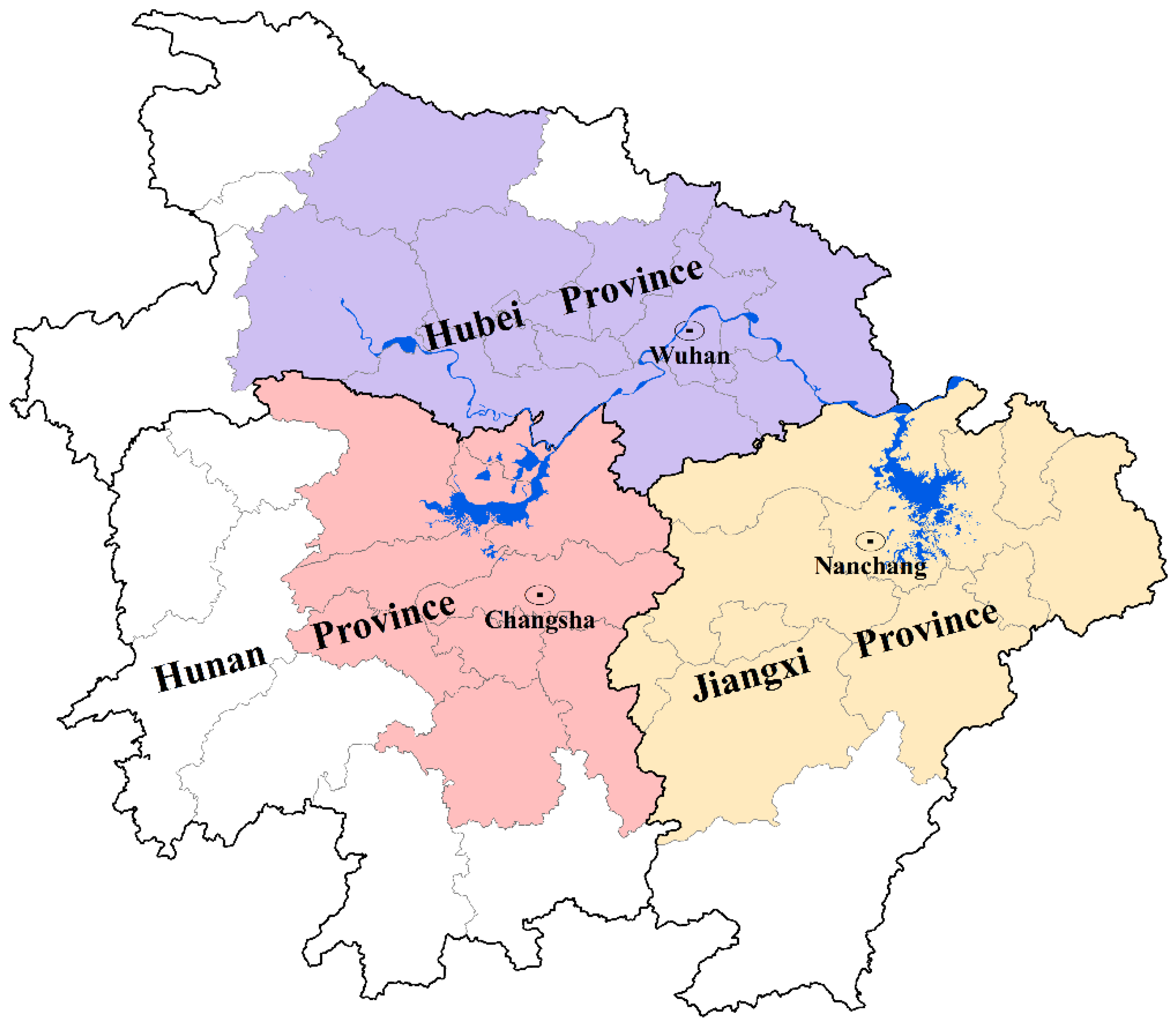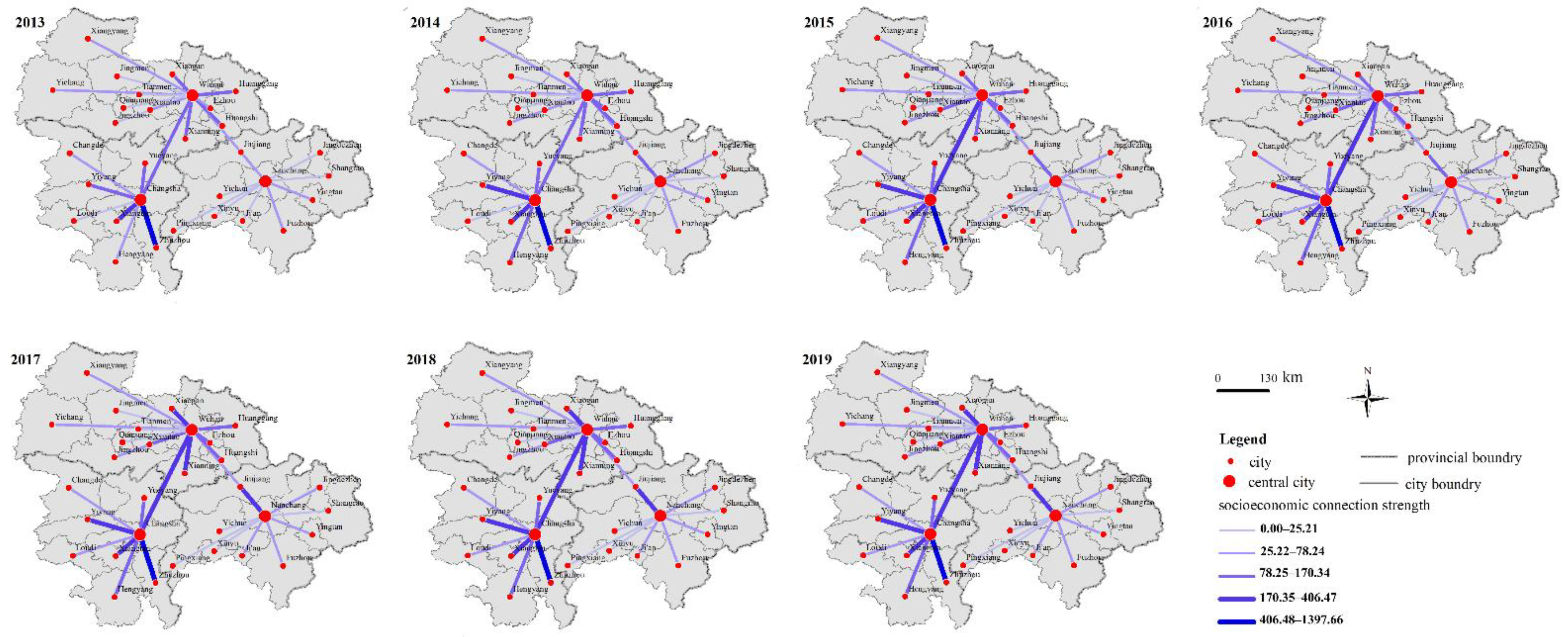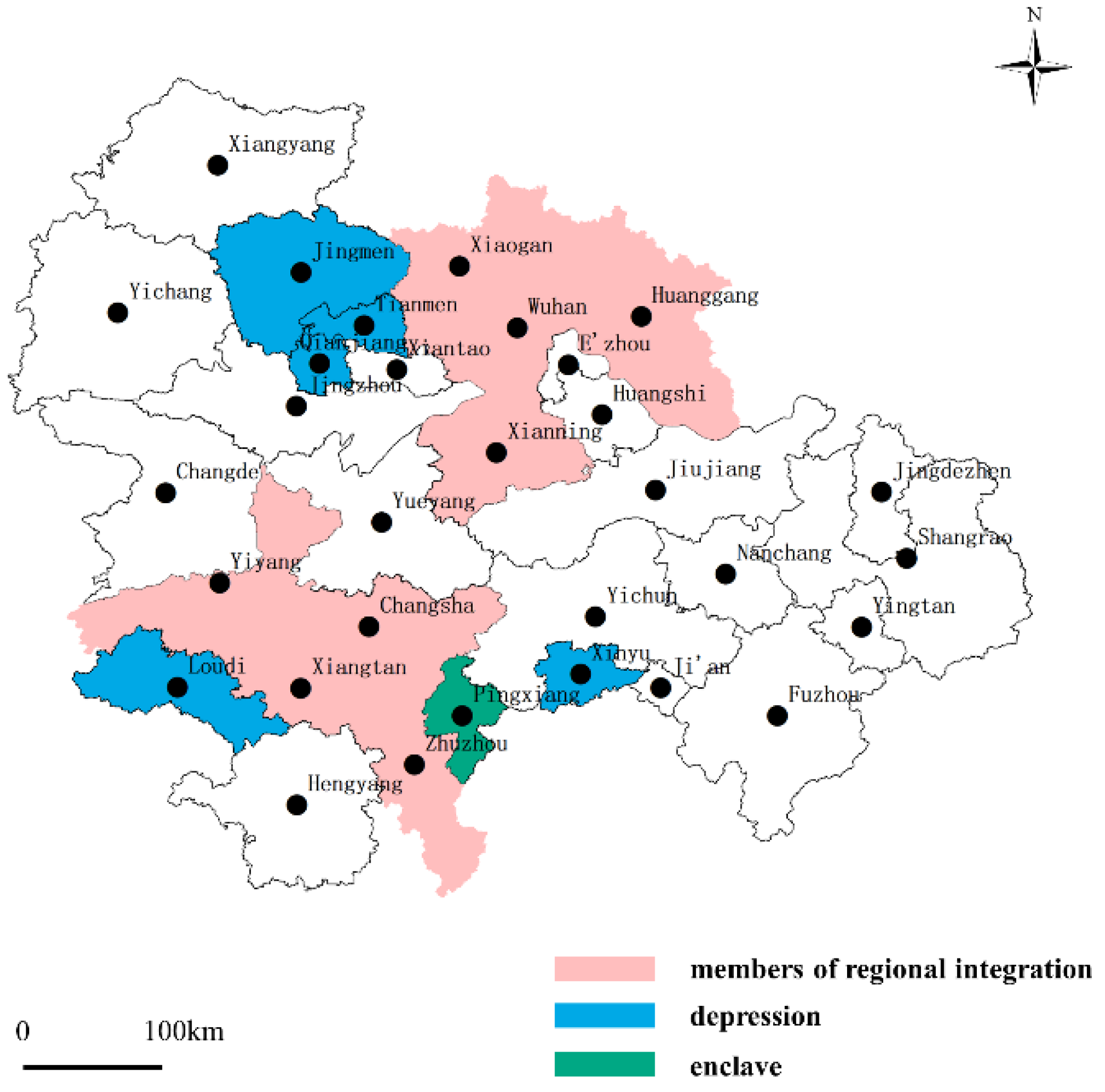Understanding the Regional Integration Process from the Perspective of Agglomeration and Urban Networks: Case Study in Central China
Abstract
:1. Introduction
2. Framework for Understanding Regional Integration from the Perspective of Agglomeration and Urban Networks
2.1. Literature Review
2.2. Theoretical Background
2.2.1. Theoretical Framework
2.2.2. Conception: Coupling Distance
- Passive state: if a peripheral city’s ability to offer comparative advantages and receive elements from the central city gradually weakens or competition with other cities pushes it out of the arena, it then becomes an “agglomeration shadow” within the urban agglomeration.
- Active state: occurs when either the sending system (i.e., the peripheral city) actively seeks external contact and can thus divert its attention from the original core or the original center loses its centrality, thereby removing a member from the group. In both scenarios, the peripheral city becomes an “enclave” within the urban agglomeration.
3. Study Area, Data and Methods
3.1. Research Setting: Urban Agglomeration in the Middle Reaches of the Yangtze River
3.2. Data
3.3. Model and Measures
4. Results
4.1. Response of Spatial Hindering to the Range of the Urban Agglomeration
4.2. State of Integration and Concrete Members of the Urban Agglomeration
5. Discussion
6. Conclusions
Author Contributions
Funding
Data Availability Statement
Conflicts of Interest
References
- Fang, C.; Yu, X.; Zhang, X.; Fang, J.; Liu, H. Big data analysis on the spatial networks of urban agglomeration. Cities 2020, 102, 102735. [Google Scholar] [CrossRef]
- Zhao, J.; Zhu, D.; Cheng, J.; Jiang, X.; Lun, F.; Zhang, Q. Does regional economic integration promote urban land use efficiency? Evidence from the Yangtze River Delta, China. Habitat Int. 2021, 116, 102404. [Google Scholar] [CrossRef]
- Brezzi, M.; Veneri, P. Assessing polycentric urban systems in the OECD: Country, regional and metropolitan perspectives. Eur. Plan. Stud. 2015, 23, 1128–1145. [Google Scholar] [CrossRef]
- Fang, C.; Yu, D. Urban agglomeration: An evolving concept of an emerging phenomenon. Landsc. Urban Plan. 2017, 162, 126–136. [Google Scholar] [CrossRef]
- Shen, L.; Cheng, G.; Du, X.; Meng, C.; Ren, Y.; Wang, J. Can urban agglomeration bring “1 + 1> 2Effect”? A perspective of land resource carrying capacity. Land Use Policy 2022, 117, 106094. [Google Scholar] [CrossRef]
- Krugman, P. Increasing returns and economic geography. J. Political Econ. 1991, 99, 483–499. [Google Scholar] [CrossRef]
- Capello, R. The city network paradigm: Measuring urban network externalities. Urban Stud. 2000, 37, 1925–1945. [Google Scholar] [CrossRef]
- Ke, S.; Feser, E. Count on the growth pole strategy for regional economic growth? Spread–backwash effects in Greater Central China. Reg. Stud. 2010, 44, 1131–1147. [Google Scholar] [CrossRef]
- Camagni, R.; Capello, R.; Caragliu, A. The rise of second-rank cities: What role for agglomeration economies? Eur. Plan. Stud. 2015, 23, 1069–1089. [Google Scholar] [CrossRef]
- McPhearson, T.; Haase, D.; Kabisch, N.; Gren, Å. Advancing understanding of the complex nature of urban systems. Ecol. Indic. 2016, 70, 566–573. [Google Scholar] [CrossRef]
- Meijers, E.J.; Burger, M.J.; Hoogerbrugge, M.M. Borrowing size in networks of cities: City size, network connectivity and metropolitan functions in Europe. Pap. Reg. Sci. 2016, 95, 181–198. [Google Scholar] [CrossRef] [Green Version]
- Meijers, E.J.; Burger, M.J. Stretching the concept of ‘borrowed size’. Urban Stud. 2017, 54, 269–291. [Google Scholar] [CrossRef]
- Fang, C. The basic law of the formation and expansion in urban agglomerations. J. Geogr. Sci. 2019, 29, 1699–1712. [Google Scholar] [CrossRef] [Green Version]
- Shi, Y.; Cao, X.; Shi, D.; Wang, Y. The “one-city monopoly index”: Measurement and empirical analysis of China. Cities 2020, 96, 102434. [Google Scholar] [CrossRef]
- Bosker, M.; Buringh, E. City seeds: Geography and the origins of the European city system. J. Urban Econ. 2017, 98, 139–157. [Google Scholar] [CrossRef] [Green Version]
- Hodgson, C. The effect of transport infrastructure on the location of economic activity: Railroads and post offices in the American West. J. Urban Econ. 2018, 104, 59–76. [Google Scholar] [CrossRef]
- Glaeser, E.L.; Ponzetto, G.A.; Zou, Y. Urban networks: Connecting markets, people, and ideas. Pap. Reg. Sci. 2016, 95, 17–59. [Google Scholar] [CrossRef] [Green Version]
- Camagni, R.; Capello, R.; Caragliu, A. Static vs. dynamic agglomeration economies: Spatial context and structural evolution behind urban growth. In Seminal Studies in Regional and Urban Economics; Springer: Cham, The Netherlands, 2017; pp. 227–259. [Google Scholar] [CrossRef]
- Duranton, G. Determinants of city growth in Colombia. Pap. Reg. Sci. 2016, 95, 101–131. [Google Scholar] [CrossRef]
- Beckfield, J. Unequal Europe: Regional Integration and the Rise of European Inequality; Oxford University Press: Oxford, UK, 2019. [Google Scholar]
- Bouvet, F. Regional integration and income inequality: A synthetic counterfactual analysis of the European Monetary Union. Oxf. Rev. Econ. Policy 2021, 37, 172–200. [Google Scholar] [CrossRef]
- Neal, Z. Does world city network research need eigenvectors? Urban Stud. 2013, 50, 1648–1659. [Google Scholar] [CrossRef]
- World Bank. World Development Report 2009: Reshaping Economic Geography; The World Bank: Bretton Woods, NH, USA, 2008. [Google Scholar]
- Scott, A.J. World Development Report 2009: Reshaping economic geography. J. Econ. Geogr. 2009, 9, 583–586. [Google Scholar] [CrossRef]
- Zhang, M.; Liu, Y.; Wu, J.; Wang, T. Index system of urban resource and environment carrying capacity based on ecological civilization. Environ. Impact Assess. Rev. 2018, 68, 90–97. [Google Scholar] [CrossRef]
- Otsuka, A. Inter-regional networks and productive efficiency in Japan. Pap. Reg. Sci. 2020, 99, 115–133. [Google Scholar] [CrossRef]
- Ejones, F.; Agbola, F.W.; Mahmood, A. Regional integration and economic growth: New empirical evidence from the east African community. Int. Trade J. 2021, 35, 311–335. [Google Scholar] [CrossRef]
- Shukla, S. Common South Asian Identity and Regional Integration in South Asia. Political Discourse 2021, 7, 196–211. [Google Scholar] [CrossRef]
- Li, K.; Hou, Y.; Andersen, P.S.; Xin, R.; Rong, Y.; Skov-Petersen, H. An ecological perspective for understanding regional integration based on ecosystem service budgets, bundles, and flows: A case study of the Jinan urban agglomeration in China. J. Environ. Manag. 2022, 305, 114371. [Google Scholar] [CrossRef]
- Alinsato, A.S. Regional Integration in the West African Economic and Monetary Union (WAEMU): Complementarity or Competition? Economies 2022, 10, 22. [Google Scholar] [CrossRef]
- Lin, G.C. Regional integration in South China: Processes and consequences in a local economy of the Pearl River Delta. Asian Perspect. 2021, 25, 93–125. [Google Scholar] [CrossRef]
- Krugman, P.; Elizondo, R.L. Trade policy and the third world metropolis. J. Dev. Econ. 1996, 49, 137–150. [Google Scholar] [CrossRef]
- Fujita, M.; Thisse, J.F. Economics of Agglomeration: Cities, Industrial Location, and Regional Growth; Cambridge University Press: Cambridge, UK, 2002. [Google Scholar]
- Chen, Y.; Sun, B.D. Does “agglomeration shadow” exist in Beijing-Tianjin-Hebei region? Large cities’ impact on regional economic growth. Geogr. Res. 2017, 36, 1936–1946. [Google Scholar] [CrossRef]
- McCann, P.; Acs, Z.J. Globalization: Countries, cities and multinationals. Reg. Stud. 2011, 45, 17–32. [Google Scholar] [CrossRef] [Green Version]
- Burger, M.J.; Meijers, E.J. Agglomerations and the rise of urban network externalities. Pap. Reg. Sci. 2016, 95, 5–15. [Google Scholar] [CrossRef]
- Liu, J.; Dietz, T.; Carpenter, S.R.; Alberti, M.; Folke, C.; Moran, E.; Taylor, W.W. Complexity of coupled human and natural systems. Science 2007, 317, 1513–1516. [Google Scholar] [CrossRef] [PubMed] [Green Version]
- Bertalanffy, L.V. General System Theory: Foundations, Development, Applications; George Braziller, Inc.: New York, NY, USA, 1969. [Google Scholar]
- Qian, X.S.; Xu, G.Z.; Wang, S.Y. Organizational management technology-systems engineering. Univ. Shanghai Sci. Technol. 2011, 33, 520–526. [Google Scholar] [CrossRef]
- Gao, X.; Xu, Z.; Niu, F. Delineating the scope of urban agglomerations based upon the Pole-Axis theory. Prog. Geogr. 2015, 34, 280–289. [Google Scholar] [CrossRef]
- Hesse, M. The Polycentric Metropolis: Learning from Mega-city Regions in Europe—Edited by Peter G. Hall and Kathy Pain. Int. J. Urban Reg. Res. 2007, 31, 496–498. [Google Scholar] [CrossRef]
- Wilson, A. Entropy in Urban and Regional Modelling: Retrospect and Prospect. Geogr. Anal. 2010, 42, 364–394. [Google Scholar] [CrossRef]
- Xiong, L.F.; Zhen, F.; Wang, B.; Xi, G.L. The research of the Yangtze River Delta core area’s city network characteristics based on Baidu index. Econ. Geogr. 2013, 33, 67–73. [Google Scholar] [CrossRef]
- Xie, Y.Q. A new potential function for polyatomic interactions in solids. Sci. China 1992, 8, 880–890. (In Chinese) [Google Scholar]
- Huff, D.L.; Lutz, J.M. Urban spheres of influence in Ghana. J. Dev. Areas 1989, 23, 201–220. [Google Scholar]
- Fragkias, M.; Seto, K.C. Evolving rank-size distributions of intra-metropolitan urban clusters in South China. Comput. Environ. Urban Syst. 2009, 33, 189–199. [Google Scholar] [CrossRef]
- Small, C.; Elvidge, C.D.; Balk, D.; Montgomery, M. Spatial scaling of stable night lights. Remote Sens. Environ. 2011, 115, 269–280. [Google Scholar] [CrossRef]
- Zhang, Q.; Seto, K.C. Can night-time light data identify typologies of urbanization? A global assessment of successes and failures. Remote Sens. 2013, 5, 3476–3494. [Google Scholar] [CrossRef] [Green Version]
- Wang, X.; Wu, D.T.; Wang, H.Q. An attempt to calculate economic links between cities. Urban Stud. 2006, 13, 55–59. (In Chinese) [Google Scholar]
- Wang, S.Y.; Qin, Z.Y.; Dai, L.; Wang, X.L. Spatial economic connection and network structure of urban agglomerations in the middle reaches of the Yangtze River—By using the methods of transportation cost and network analysis. Econ. Geogr. 2013, 33, 64–69. [Google Scholar] [CrossRef]
- Tobler, W.R. A computer movie simulating urban growth in the Detroit region. Econ. Geogr. 1970, 46, 234–240. [Google Scholar] [CrossRef]
- Zhang, B.Y. Study on Evolution of Spatial Structure and Spatial Integration in Wuhan Metropolitan Circle. Ph.D. Thesis, Central China Normal University, Wuhan, China, 2015. [Google Scholar]
- Yu, Y.; Tong, Y.; Han, S.S.; Ke, Y.Y.; Tong, Y. Spatiotemporal evolution of spatial interaction among cities of Wuhan urban agglomeration. Resour. Environ. Yangtze Basin 2017, 26, 1784–1794. [Google Scholar]
- Chen, Q.; Song, Y. Methods of dividing the boundary of urban agglomerations: Chang-Zhu-Tan Urban Agglomeration as a case. Sci. Geogr. Sin. 2010, 30, 660–666. [Google Scholar] [CrossRef]
- Li, C.; Zhou, Q.; Ma, K.; Fang, J.; Yang, W. Research on Traffic Accessibility and Transportation Integration Level of Chang-Zhu-Tan City Group in China. J. Geogr. Inf. Syst. 2019, 11, 715. [Google Scholar] [CrossRef] [Green Version]
- Lao, X.; Shen, T.Y.; Yang, Y.; Zhang, Y. A Study on the economic network of the urban agglomeration in the Middle Reaches of the Yangtze River: Based on social network analysis method with gravity model. Urban Stud. 2016, 23, 91–98. [Google Scholar] [CrossRef]
- Fang, C.L.; Song, J.T.; Zhang, Q.; Li, M. The Formation, development and spatial heterogeneity patterns for the structures system of urban agglomerations in China. Acta Geogr. Sin. 2005, 60, 827–840. [Google Scholar] [CrossRef]
- Tang, F.H.; Tang, H.; Sun, Q.; Tang, D. Analysis of the economic network structure of urban agglomerations in the middle Yangtze River. Acta Geogr. Sin. 2013, 68, 1357–1366. [Google Scholar]
- Lappo, G.M.; Lyubovnyi, V.Y. Largest urban agglomerations in Russia at the beginning of the 21st century: Status, problems, and approaches to solving them. Reg. Res. Russ. 2011, 1, 133–140. [Google Scholar] [CrossRef]
- Moghadam, H.S.; Helbich, M. Spatiotemporal urbanization processes in the megacity of Mumbai, India: A Markov chains-cellular automata urban growth model. Appl. Geogr. 2013, 40, 140–149. [Google Scholar] [CrossRef]
- Suárez, M.; Murata, M.; Delgado Campos, J. Why do the poor travel less? Urban structure, commuting and economic informality in Mexico City. Urban Stud. 2016, 53, 2548–2566. [Google Scholar] [CrossRef]






| Classification | Integrated Response Status | Meaning |
|---|---|---|
| 0 < ≤ 2Ds | weak response | the peripheral cities and the central cities have weak connections or even have no connection; |
| = 0 | integrated initial response | the strength of interconnection between peripheral cities and central cities initially offsets the spatial interference; |
| ∣∣ ≥ 2Ds, < 0 | fully responsive integration | peripheral cities and central cities completely overcome all interference and obstacles and they enter complete integration; |
| ∣∣ ≥ 4Ds, < 0 | bidirectional response | the peripheral cities have the ability to attract the central cities in a reverse direction, and they finally form a community of interests. |
Publisher’s Note: MDPI stays neutral with regard to jurisdictional claims in published maps and institutional affiliations. |
© 2022 by the authors. Licensee MDPI, Basel, Switzerland. This article is an open access article distributed under the terms and conditions of the Creative Commons Attribution (CC BY) license (https://creativecommons.org/licenses/by/4.0/).
Share and Cite
Wang, L.; Zhang, F.; Zang, Y.; Duan, J. Understanding the Regional Integration Process from the Perspective of Agglomeration and Urban Networks: Case Study in Central China. Int. J. Environ. Res. Public Health 2022, 19, 12834. https://doi.org/10.3390/ijerph191912834
Wang L, Zhang F, Zang Y, Duan J. Understanding the Regional Integration Process from the Perspective of Agglomeration and Urban Networks: Case Study in Central China. International Journal of Environmental Research and Public Health. 2022; 19(19):12834. https://doi.org/10.3390/ijerph191912834
Chicago/Turabian StyleWang, Liang, Fangfang Zhang, Yuzhu Zang, and Jian Duan. 2022. "Understanding the Regional Integration Process from the Perspective of Agglomeration and Urban Networks: Case Study in Central China" International Journal of Environmental Research and Public Health 19, no. 19: 12834. https://doi.org/10.3390/ijerph191912834





